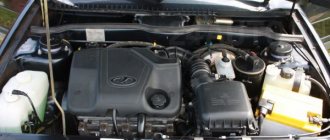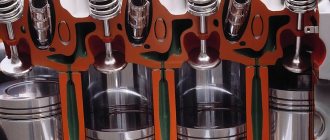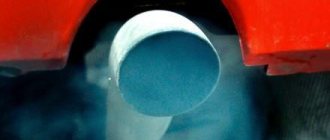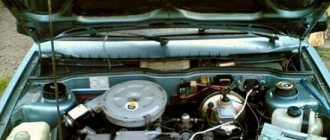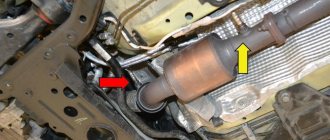If the VAZ 2110 8-valve engine, the 8-valve injector begins to show signs of instability in operation, this means that 1 of the cylinders has stopped performing its functions. Such a breakdown should be repaired immediately, because unburned fuel mixture enters the crankcase and changes the viscosity of the oil. As a result, the contacting surfaces of the unit parts are not covered with an oil film of sufficient consistency. There is increased wear of elements.
Causes of unstable engine operation
Content
When a VAZ 2110 engine with an 8-valve injector malfunctions, the reasons are sought in a certain sequence.
Systems and individual components are checked:
- electrician;
- cylinder operation;
- ignition;
- degree of depressurization;
- air supply;
- fuel injectors;
- pistons and rings;
- sensors
Electrics
When the engine of a VAZ 2110 8-valve injector malfunctions, the reasons, first of all, should be sought in the electrics.
Only after this is it possible to establish unstable operation of the cylinder. First, the candles are inspected:
- Using a special key, they are unscrewed sequentially.
- A superficial inspection of the insulator is being carried out.
- Often the cause of a weak spark or its complete absence is surface deposits, which are eliminated.
- Check that the spark plug gap is set correctly.
- The cap is inspected for wear.
When the VAZ 2110 engine has trouble with the 8-valve injector, the reasons may lie in the high-voltage wires. To do this, a tester is used that checks them for resistance, the optimal value of which is 5 ohms. If the wires do not meet this specification, they need to be replaced.
There is also a lack of spark due to the following reasons:
- ignition coil malfunction;
- broken wires.
The spark plug operation is checked in the following sequence:
- The spark plug tip is inserted into the wire.
- Its opposite end is applied in mass.
- The starter turns on.
- If a spark jumps, it means the element is working.
- If it is missing, the spark plug requires cleaning or replacement.
Cylinder operation
If the VAZ 21108 engine has 8 valve injector valves, then a possible cause may be poor cylinder performance.
When it is determined that everything is in order with the electrical part, the following actions are carried out:
- The hood lid is installed in the open position and the VAZ car starts.
- To determine the tripping of one of the cylinders, 1 wire is removed one at a time.
- Each time you should listen to the tone of the machine's noise. Her work must become unsustainable.
- If the next time you remove the wire, the sound does not change, it means that this cylinder has a malfunction.
Knowing that the voltage is coming through the wire, a search is being carried out for another reason why the VAZ 2110 engine is having problems with the 8-valve injector.
Ignition
VAZ 2110 engine 8 valves, the injector may trip if the coil is faulty.
To check, the following steps are carried out:
- The terminal is disconnected from the coil.
- It has 4 connectors: power, ground and 2 control lines.
- A multimeter is connected in series to each connector.
- The voltage at 1 connector must correspond to 12 V.
- At ground the resistance should be around 1 Ohm.
- By connecting the device to the control lines, the starter turns the crankshaft. The device should show at least 0.3 V.
If 1 of these indicators is not met, this will be the reason why the VAZ 2110 8-valve engine has an injector problem.
Depressurization of the system and air leaks
If the VAZ 2110 engine has trouble, the cause of the malfunction may lie in excess air supply.
As a result of depressurization, uncontrolled suction occurs, which leads to disruption of the functioning of the system. To check for a leak, carry out the following steps:
- There is a valve next to the air filter that closes.
- This leads to an artificial increase in pressure.
- It immediately becomes clear where the air leak is coming from.
Insufficient amount of air in the combustible mixture
If there is a lack of air in the combustible mixture, the VAZ 2110 8-valve engine and 8-valve injector may also begin to stall.
The following problems exist:
- The capacity of the air filter has deteriorated. This happens due to its contamination. To check the unit, dismantle it and start the car. If no changes are observed, then this unit requires replacement.
- Another reason why the VAZ 2110 8 valve injector troits is the throttle. This element needs constant monitoring. During maintenance, in parallel with changing the oil and all filters, this part must be cleaned. For this purpose, VD-40 is used, which removes dirt well from the surface.
Fuel injectors
VAZ 2110 engine 8 valves, the injector may triple due to a malfunction of the injectors, as well as the fuel rail.
To understand how faulty the injectors are, a stand is used that provides complete information about them. In some cases, they need cleaning, which is also carried out at the stand. The ramp is also subjected to external examination for cracks or dents.
Pistons and rings
A malfunction in the piston system often leads to the fact that the VAZ 2110 engine begins to misfire.
It depends on the mileage traveled by the car. Unstable operation occurs for the following reasons:
- There is wear on the rings and pistons. Not only is there an increased consumption of lubricant, but the operation of the unit also deviates from the norm. In this case, you should hurry up with a major overhaul.
- Piston burnout. This happens because the rings allow oil to pass through, which burns in the piston. This leads to their burning out.
- When the valves burn, the gap increases. As a result, exhaust gases begin to flow, and the car's performance deteriorates.
These reasons lead to a decrease in compression. It is checked by adding oil to the cylinder. If its performance has increased, then the piston group requires replacement.
Sensors
If sensors fail, this affects the unstable operation of the car. This is due to the fact that the nodes send a signal to the electronic unit. If it is absent, the receipt of commands to control the machine stops.
To identify a malfunction, each sensor is checked individually until the faulty element is found.
If the Lada Priora's starter does not turn
| Possible malfunction | Diagnostics | Remedies |
| Low battery | The voltage at the battery terminals without load is less than 12V. When trying to start the engine, a cracking noise is heard from under the hood. | Charge the battery or replace it with a new one |
| Oxidation of battery terminals or wire terminals, their fit is not tight | When you try to start the car, the voltage in the on-board network drops much more than at the battery terminals. In this case, a crash may be heard under the hood. | Clean the contacts, lubricate them with petroleum jelly and tighten the terminals |
| The engine or attachments are jammed | Check the rotation of the crankshaft, pump and generator pulley. | Repair engine, generator, pump |
| The starter is faulty, the starter drive gear or flywheel ring teeth are damaged | Remove and inspect the starter. | Repair or replace starter |
| The starter switching circuit or starter relay is faulty, the wires are damaged, or the ignition switch contacts do not close | When the key is turned to position “II”, the starter traction relay does not operate (a click is not heard under the hood). Check the +12V supply to the control contact of the traction relay. | Replace starter relay, wires, ignition switch |
| The starter traction relay is faulty, there is a short circuit or break in the retractor winding, the relay armature is stuck | When the key is turned to position “II”, the traction relay does not operate (there is no click under the hood), but + 12V is supplied to the control contact of the traction relay. Remove the relay and check its operation. | Replace the traction relay |
| Contacts or wires of the traction relay are oxidized, poor ground contact | When the starter is turned on, a clicking sound is heard under the hood, but the starter armature does not rotate. Using an ohmmeter, check the resistance of the Battery-Starter circuit, as well as the ground wire. If the circuit is in good condition, remove the starter and check the operation of the traction relay by applying +12V to it from the battery | Tighten the terminals, clean the contacts, replace the traction relay |
| Open or short circuit in the holding winding of the traction relay | When you try to start the engine, you hear a crashing sound under the hood. The battery voltage is within normal limits. We check the traction relay with an ohmmeter or by its excessive heating. | Replace the traction relay |
| Burning of the starter commutator, sticking of the brushes or their severe wear. Break or short circuit in the starter armature winding | The starter armature rotates slowly or does not rotate at all. Check the traction relay by applying voltage to the starter contact bolt directly from the battery | Replace starter or armature |
| Freewheel slipping | When the starter is turned on, the armature rotates, the flywheel is stationary | Replace clutch or starter |
Reasons for engine tripping 16 valve injector
If the VAZ 2110 engine has problems with the 16 valve injector, then the reasons have some features:
- High voltage coils. Their quantity is 4 pcs. They are located under the lid. It is removed during inspection. To establish the serviceability of each coil individually, the bolt located next to each element is unscrewed. Then the car starts and the terminal is removed. If the noise of the machine does not change, then the unit is faulty. Each coil is checked this way.
- Faulty sensors located on the crankshaft or camshaft lead to vehicle malfunction.
Ignition
Before checking the entire system, it is necessary to identify the inoperative cylinder. This is done as follows: the high-voltage wires are pulled off the spark plugs one by one.
At the same time, the working cylinders react to this action, the engine begins to wither. If the non-working cylinder is disconnected from the ignition, the engine will not react to this in any way. After determining the inoperative cylinder, unscrew the spark plug. Problems with it or with the ignition system are indicated by the presence of fuel residues on it, the spark plug is “wet”. You can try replacing the spark plug and installing another high voltage. You may find that when you start the engine, it runs fine. If this does not happen, you need to continue checking. The simplest solution is to replace your module with one that is known to work. If this is the problem, then the engine should start working correctly. You can also check with a multimeter. To do this, you need to measure the resistance at the terminals. This needs to be done in pairs. Combine cylinders 1 and 4, as well as cylinders 2 and 3. The resistance should be between 5.2 and 5.5 ohms. The ignition module cannot be repaired; if it malfunctions, it will have to be replaced.
Causes of carburetor engine tripping
If the engine of a VAZ 2110 8-valve carburetor fails, then the reasons are as follows:
- Setting the quantity and quality of the mixture. The carburetor has mixture quantity and quality screws that need to be adjusted.
- If the engine of a VAZ 2110 fails, the reasons lie in clogged jets and idle channels.
- The gasket that allows air to pass through is broken. This makes the combustible mixture leaner.
- When the VAZ 2110 engine stalls, the cause may be a malfunction of the carburetor magnetic valve.
- The float system is not adjusted correctly. As a result, the fuel level decreases. This leads to the fact that the engine on the VAZ 2110 8 valves will operate unstably.
- The filters that allow gasoline to pass through are clogged.
- The ignition system distributor is malfunctioning.
If the engine in a VAZ fails, then you should start by checking the spark plugs. Most often the reason is their contamination. If this does not bring results, then you need to start looking for more serious reasons.
Diagnostics
So, to determine the specific reason for the long start-up of an injection-injected internal combustion engine, you should start with a high-quality diagnosis. Usually, they check the compression in the cylinders. Its values must be within 12 atm for this to be considered normal. In this case, there should be no deviations between these indicators in each of the cylinders (maximum - 1 atm).
Then the spark plugs must be replaced. This will have an effect on the engine and it will now start much faster. However, if everything is not in order with the motor, then the normal starting time will last only 1-2 days.
Therefore, high-voltage wires should also be diagnosed. Diagnostics will make it possible to find out whether the cables have a breakdown, which is clearly visible by the spark coming out at night. This is done as follows: the car starts in the dark, at the same time you need to monitor which wire sparks.
The ignition coil also needs to be checked. Many experienced drivers do this: they install a known good and new module instead of the original one, then check the engine starting for several days. If everything is normal, the start-up does not take long - it means that the whole problem was in the bobbin (ignition coil).
If there are no changes, the test continues. This time you should test all filters, including the air filter. Next - check and replace all sensors and regulators
Pay special attention to the air flow sensor
The next stage: testing various connections, checking the wiring for good contact, cleaning the masses and flushing the throttle assembly.
If nothing changes again, then it is recommended to check the engine fan relay. It often causes similar problems with starting on a fuel-injected internal combustion engine. You can test the relay if you remove the wire from the temperature controller installed on the thermostat.
The fan should turn on after these steps. However, after measuring the resistance value on a warm internal combustion engine, the system can produce low temperature data, although the temperature inside the engine is clearly more than 90 degrees. Why is there such a difference? It turns out that this may well be a buggy DTOZH, which for some reason was not checked earlier. It must show the real coolant temperature, otherwise chaos will begin in the system, and it is not surprising that the engine takes so long to start.
Problems with injection
Certain specific problems can cause tripping when the engine is running in a car:
- malfunction of the regulator responsible for idle speed;
- blockage in the injection nozzle;
- the fuel pump, air or fuel filter is clogged;
- the sensor responsible for the throttle position has failed;
- the ventilation system providing air to the engine crankcase is clogged;
- ECU is faulty.
Separately, it is necessary to note the problems of the “tens” with sensors. Although their cost is insignificant, problems with them arise quite often. They often require replacement. First of all, this applies to the sensor responsible for mass fuel consumption. The second most common problem is the sensor that is responsible for the throttle position. The risk zone is not complete without an idle air regulator. All these elements require constant monitoring of their condition.
The motor may not operate correctly if the firmware of the electronic control part is poor. This can happen if tuning is used unwisely. At high speeds the car operates normally, but at idle it starts to shake. Sometimes the ECU may have defects that cannot be corrected. In this case, the only way out of this situation is to completely replace the electronic unit.
It would be a good idea to check the exhaust manifold for leaks. It doesn’t hurt to inquire about the condition of the vacuum brake booster. If it malfunctions, the spark plugs may get wet, which will also cause the engine to start to “trouble.”
We can only hope that the article will help car owners in solving this problem.
VAZ 2110 troits at low speeds
Engine problems, even episodic ones, always need to be addressed immediately. For example, it happens that at times the engine of a VAZ 2110 stalls, and many do not pay attention to this, continuing to operate the car as if nothing had happened. But this is the wrong attitude to this problem. Let’s look at the causes of this symptom and consider ways to quickly eliminate them.
When is it time to check the engine?
The engine should always run like a clock, that is, smoothly and without jerking, failures, or jumps.
At idle speed it is easy to notice that the engine is unstable. When such suspicions creep in, it is better to raise the hood and listen to the beats in all cylinders. “Troit” means one or two cylinders are inactive, since there are no conditions necessary to ensure the processes in their combustion chambers. As a result, the actual power of the power unit drops noticeably and gasoline consumption increases. There is also a tendency to stall, for example at intersections, at traffic lights or while warming up. At the same time, when the engine of a VAZ 2110 fails, the reasons for such a malfunction can be different. You can find out which cylinder has problems in one simple and long-known way. With the engine running, you need to remove the high-voltage wire from each spark plug one by one. If the cylinder was working properly before, then when it is turned off there will be a noticeable dip and a drop in speed (look at the tachometer scale). If there are no changes after removing the wire from the spark plug, we can safely assume that the problem is precisely in this cylinder - it was not working before the shutdown.
Causes of unstable motor operation
Here is an approximate and incomplete list of reasons for the “ten” engine tripping:
- spark plug malfunction, getting wet;
- breakdown of a high-voltage wire;
- extremely low quality gasoline;
- air leaks in the vacuum brake booster system;
- loss of tightness in the area of the intake manifold;
- need for valve adjustment;
- valve or piston burnout;
- development of valve levers;
- breakage of piston rings;
- cylinder head gasket breakdown;
- deterioration or unsuitability of valve stem seals.
We will not dwell on all the points one by one, but it makes sense to note some methods for quickly identifying easily repairable breakdowns. So, for example, a non-working candle becomes an elementary problem. The same applies to broken armored wires. The easiest way to identify a malfunction is to replace each of these elements one by one with a known working one. It is also sometimes possible to notice sparking in the dark, which will indicate to you a damaged high-voltage wire.
There can be plenty of discussion about problems with valves, because such a “disease” is very typical for VAZ engines. First of all, we must not forget that every 10-20 thousand km the valves must be adjusted so that they are completely closed or opened during operation. But infrequent cases of valve and even piston burnout require accurate measurements of compression in the cylinders and subsequent opening of the power unit. In this case, the wear and tear of the piston rings is determined by pouring a small amount of engine oil into the cylinder - if the compression has increased, then the problem is most likely in the rings.
Crankshaft position sensor (CPS)
Often the engine stalls due to problems with the DPKV. To check, you will have to remove this sensor from the engine. Be sure to mark its position on the engine.
After removal, you need to measure the resistance of the sensor inductive coil. The multimeter should show a resistance between 550 and 750 ohms. Anything more or less indicates a sensor malfunction. It needs to be replaced. There are other testing methods, but they are “difficult to apply” in a regular garage.
Now a short video with another reason.
Carburetor faulty
Many car enthusiasts have wondered why the engine stalls at speed, especially in carburetor cars. This has to do with the fuel supply. If the carburetor is severely worn, fuel does not flow evenly into the cylinders, but, accordingly, either a lot or a little. In this case, after pressing the gas pedal to overtake or advance, fuel enters the intake manifold unevenly, the engine begins to “chop” and shoot into the exhaust.
To eliminate the malfunction, it is necessary to dismantle the carburetor and clean it with a bulkhead. To do this you will need a repair kit. Most motorists do not contact a car service center to carry out such an operation, but carry out the repairs themselves, since the procedure is quite simple. The only subtlety is the setting and adjustment of the injection element.
Conclusion
The main reasons for the VAZ 2110 8-valve engine tripping are identified, and methods for solving the problem are described. So, the main problems arise due to an incorrect air-fuel mixture, the formation of a spark or in the piston mechanism. There are different ways to solve the problem.
But, it is recommended to turn to professionals in solving such problems who can do everything quickly and efficiently. Because improper repairs can lead to even bigger problems, which will entail additional costs.
Source
Let's start with why the engine triples, and not “doubles” or “quadruples”, for example :-)
The fact is that quite recently most engines had four cylinders, probably no one would have believed that there could be six, eight or twelve 30 years ago, but oh well... In general, when one of the four cylinders stopped working, then the workers There were only three cylinders left, and the sound of the engine was seriously changing. This phenomenon is called engine throttling, that is, the engine runs on three cylinders with a characteristic sound. Years passed, the number of cylinders changed, but the term troit remained unchanged.
Solution methods
Now that the main causes have been identified, you can proceed directly to troubleshooting methods . Before we begin, it is worth noting that not all faults can be identified independently, much less eliminated. Let's look at what needs to be done to eliminate engine tripping.
Fuel rail and injectors
The most common cause of engine tripping is a malfunction of the injectors and fuel rail. To eliminate the cause, it is necessary to disassemble this element. The fuel rail is inspected for cracks and deformations. But with candles, not everything is as simple as it seems at first glance.
To determine the performance of the elements, they need to be run through a special stand, which will show whether the injector will work. If they become clogged, they must be cleaned at a nozzle cleaning stand, and if the element is completely faulty, then replace it with a new one.
Spark plugs and wires
Another reason why the power unit fails is the spark plugs and high-voltage wires. So, it is worth removing the elements from the engine and conducting diagnostics. Spark plugs, first of all, are inspected for integrity, and then checked on a special spark plug stand. If everything is in order with the spark plugs, then it is necessary to set the contact gap before installation.
High-voltage wires are checked with a conventional resistance tester. So, a good quality wire will have a resistance of 5 ohms. Deviation from this indicator is considered to indicate that the wires are not suitable for further use and must be replaced with new ones.
Sensors
Failure of several sensors can lead to the motor becoming unstable and tripping. This could be a failure of the TPS, IAC, camshaft sensor, or DMVR. When all these components fail, they signal the electronic engine control unit, which in turn outputs information to the driver. The malfunction can be eliminated by replacing the corresponding sensor.
There are two ways to determine the performance of the sensor - measuring each sensor one by one with a tester, or connecting to the on-board computer, where an error will pop up, decoding which you can determine the location of the problem.
Throttle valve
A faulty throttle valve can cause the engine to shake. To cure the malfunction, you need to dismantle the element and clean it. Today, there are a sufficient number of products on the auto chemical market that can be used to clean this unit.
But the most popular folk method remains carburetor cleaner, or VD-40. Both products clean out accumulated dirt and dust quite well.
Air filter
The air filter remains a known problem with engine tripping. Thus, untimely replacement of this element can lead to insufficient or incorrect formation of the air-fuel mixture. This is due to the fact that a dirty filter leads to poor air permeability and the engine simply begins to choke.
To eliminate the problem, it will be enough to replace the air filter element. Since the VAZ engine has simple design features, any motorist can cope with this task without much difficulty. So, to replace the air filter you need to get into the engine compartment. Then, unscrew the four bolts securing the air filter cover and change the filter element.
Piston rings and pistons
Another factor why the VAZ 2110 engine troits the 8-valve injector is due to the reasons in the piston mechanism. This especially applies to cars that have traveled a significant mileage. Thus, deformation of the piston rings can lead not only to tripping of the power unit, but also to increased consumption of fuel and lubricating elements.
Of course, you should understand that if these rings are the culprit for unstable engine operation, then a major overhaul is approaching, so there is no need to delay troubleshooting.
Messages 14
1 Topic by kostya.ishekov93 2014-09-05 16:12:56
- kostya.ishekov93
- New member
- Inactive
- Registration: 2014-08-04
- Messages: 28 Thanks : 3
- Auto: 2110
Topic: Resolved: The 1st cylinder does not work, there is a spark
The 1st cylinder does not work. VV is normal, new, there is a spark. The injectors are new. There is compression) what is the problem? 2110 16 valves
2 Reply from igorek 2014-09-05 16:20:03 (2014-09-05 16:24:52 edited by igorek)
- igorek
- Brother-in-law
- Inactive
- From: Bryansk region g Starodub
- Registration: 2013-05-05
- Messages: 416 Thanks : 191
- Car: VAZ-21102 1.5i-8V Bosch MP7.0H
Re: Resolved: The 1st cylinder does not work, there is a spark
kostya.ishekov93 , 1st spark plug 2nd high-voltage coil. 3rd ignition module 4th injector control circuit. Is this all normal? and checked? If everything is normal, you can sin on the computer
3 Reply from kostya.ishekov93 2014-09-05 17:30:13 (2014-09-05 17:40:05 edited by kostya.ishekov93)
- kostya.ishekov93
- New member
- Inactive
- Registration: 2014-08-04
- Messages: 28 Thanks : 3
- Auto: 2110
Re: Resolved: The 1st cylinder does not work, there is a spark
kostya.ishekov93 , 1st spark plug 2nd high-voltage coil. 3rd ignition module 4th injector control circuit. Is this all normal? and checked? If everything is normal, you can sin on the computer
I checked the spark plug. I don’t have a coil, but a module) How can I check the module, or how can I understand what’s not working properly? The chain, as I understand it, if it were acting up, the check would show) The only error the check gives is 0301 Misfire in cylinder 1
4 Reply from san 2014-09-05 17:44:57 (2014-09-05 17:46:16 edited by san)
- san
- Participant
- Inactive
- From: Len.O
- Registration: 2012-10-24
- Messages: 110 Thanks : 26
- Car: VAZ 21113 16 class, 1500
Re: Resolved: The 1st cylinder does not work, there is a spark
I think it’s necessary for diagnostics. Diagnosticians have a module check program. maybe the ecu is faulty. A friend of mine had something like this, everything was solved by replacing the ecu.
5 Reply from kostya.ishekov93 2014-09-05 17:50:34
- kostya.ishekov93
- New member
- Inactive
- Registration: 2014-08-04
- Messages: 28 Thanks : 3
- Auto: 2110
Re: Resolved: The 1st cylinder does not work, there is a spark
I think it’s necessary for diagnostics. Diagnosticians have a module check program. maybe the ecu is faulty. A friend of mine had something like this, everything was solved by replacing the ecu.
Well, it happened that at first cylinder 4 didn’t work)) but after I climbed around, changed the wires, spark plugs, checked the injectors, 1 stopped working) and 4 works)))
6 Reply from san 2014-09-06 08:36:19 (2014-09-06 08:46:40 edited by san)
- san
- Participant
- Inactive
- From: Len.O
- Registration: 2012-10-24
- Messages: 110 Thanks : 26
- Car: VAZ 21113 16 class, 1500
Re: Resolved: The 1st cylinder does not work, there is a spark
Well, there are a lot of options, there is no spark on the spark plug, the injector does not open. (I personally had this happen when the module was heating up and cut off the second and third cylinders and was found only with the help of the program). but you still need to have a specialist look at the wires, injectors, spark plugs, the gap may be large or small, and the module itself, and the ECU too.
7 Reply from kostya.ishekov93 2014-09-06 09:26:55
- kostya.ishekov93
- New member
- Inactive
- Registration: 2014-08-04
- Messages: 28 Thanks : 3
- Auto: 2110
Re: Resolved: The 1st cylinder does not work, there is a spark
Well, there are a lot of options, there is no spark on the spark plug, the injector does not open. (I personally had this happen when the module was heating up and cut off the second and third cylinders and was found only with the help of the program). but you still need to have a specialist look at the wires, injectors, spark plugs, the gap may be large or small, and the module itself, and the ECU too.
Today I looked at the errors) 1 and 3 injectors, circuit interruption. And cylinders 1 and 4 are misfiring.
Air leak
The presence of excess air in the cylinders can cause tripping. Thus, excess oxygen can enter the power unit in several ways: through a broken head gasket, or be “sucked in” through the intake manifold gasket or injector.
The most common cause is a breakdown of the cylinder head gasket. To eliminate the problem, it is necessary to replace the gasket material. To do this you will have to dismantle the block head. This will allow access to the cylinders and valves, which also need to be diagnosed.


